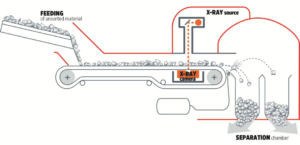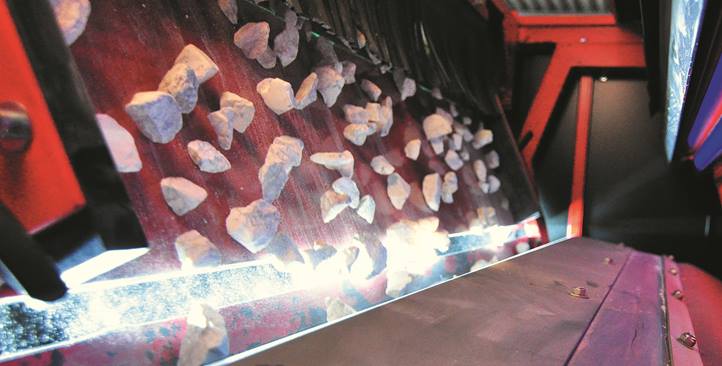X-ray Transmission (XRT) ore sorting looks to be catching on in mining, with Vancouver-based Almaden Minerals the latest company to put the technology to the test.
Almaden, which is the majority owner of the Ixtaca gold-silver project in Puebla state, Mexico, recently engaged TOMRA Sorting Solutions to run a 2,200 kg sample of material from the project through a commercial scale XRT machine in Germany and the results speak for themselves.
The limestone sample, collected from fresh drill core in the Ixtaca Main zone, was crushed and screened at a McClelland metallurgical lab in Reno, US, and shipped to TOMRA in Wedel, Germany.
The results of the tests showed XRT could successfully reject 39% of waste rock from coarse rock (18-50 mm) at grades of 0.25 g/t Au and 12 g/t Ag, and 52% of waste rock from mid-size rock (12-16 mm) at grades of 0.22 g/t Au and 12 g/t Ag. These grades were below the anticipated mine cutoff grades, but Almaden was able to elaborate further on the impact.
The results showed including conventional XRT ore sorting technology could:
- Increase average mill feed grades for the limestone unit by 39% for gold and 47% for silver
- Push the average annual metal production above the 147,900 ounces per year of gold-equivalent envisaged in Almaden’s 2017 pre-feasibility study
- Bolster the initial rate of return and payback economics of the project
- Reject 36% of run of mine as waste rock at the crushing stage
- Produce a 93% recovery for silver and 88% recovery for gold from the ore sorter
- Reduce the environmental footprint over the life of mine by:
- Reducing process tailings
- Lowering process water usage
- Cutting process energy requirements and CO2 emissions.
And, these benefits came with only a “modest impact on capital costs”, Almaden said.
XRT is becoming more prevalent in mining with several recent installations in gold, diamond and tin operations.
Morgan Poliquin, President and CEO of Almaden, said the Ixtaca deposit was particularly well suited to the technology as the occurrence of gold and silver in the limestone-hosted portions of the project is in the form of high-grade veins and veinlets that “branch and re-connect, as well as locally change strike and dip, pinch and swell”.
This can result in wireframe models that contain interspersed irregular zones of barren limestone host rock, leading to dilution.
The broad-band radiation that comes with sensor-based ore sorting and penetrates the crushed and screened mineralised rock can see beyond this and ‘reject’ what would be considered waste rock from further processing (see below graphic, credit: TOMRA).

The TOMRA test work will now go into the company’s feasibility study at Ixtaca, which is expected to be completed this year.
In the meantime, another precious metals focused company has already gone ahead and installed a commercial XRT unit in its operation.
Pantoro, in its June quarter production results, confirmed a Steinert XRT ore sorter was installed and commissioned at its Halls Creek gold mine in the Kimberley region of Western Australia.
Pantoro said: “The ore sorter will be the primary facilitator of continued production increases during the coming year. The full benefit will be achieved from the ore sorter as ore development and production from the Wagtail underground mine ramps up.”
The company is aiming for production rates of 80,000-100,000 oz/y by the end of 2018 as the ore sorter and Nicholsons process plant become fully utilised. The company produced 52,203 oz of gold in the 12 months to the end of June.











